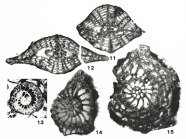Foraminifera taxon details
Sulcorbitoides Brönnimann, 1954 †
722373 (urn:lsid:marinespecies.org:taxname:722373)
accepted
Genus
Sulcorbitoides pardoi Brönnimann, 1954 † (type by original designation)
marine, brackish, fresh, terrestrial
fossil only
masculine
Brönnimann, P. (1954). Upper Cretaceous orbitoidal Foraminifera from Cuba. Part I. Sulcorbitoides n. gen. <em>Contributions from the Cushman Foundation for Foraminiferal Research.</em> 5(2): 55-61., available online at https://cushmanfoundation.allenpress.com/portals/_default/files/pubarchive/CCFFR/05ccffr2.pdf
page(s): p. 55 [details] Available for editors [request]
[request]
page(s): p. 55 [details] Available for editors
Hayward, B.W.; Le Coze, F.; Vachard, D.; Gross, O. (2024). World Foraminifera Database. Sulcorbitoides Brönnimann, 1954 †. Accessed at: https://marinespecies.org/foraminifera/aphia.php?p=taxdetails&id=722373 on 2024-08-31
Date
action
by
original description
Brönnimann, P. (1954). Upper Cretaceous orbitoidal Foraminifera from Cuba. Part I. Sulcorbitoides n. gen. <em>Contributions from the Cushman Foundation for Foraminiferal Research.</em> 5(2): 55-61., available online at https://cushmanfoundation.allenpress.com/portals/_default/files/pubarchive/CCFFR/05ccffr2.pdf
page(s): p. 55 [details] Available for editors [request]
[request]
basis of record Loeblich, A. R.; Tappan, H. (1987). Foraminiferal Genera and their Classification. Van Nostrand Reinhold Company, New York. 970pp., available online at https://books.google.pt/books?id=n_BqCQAAQBAJ [details] Available for editors [request]
[request]
page(s): p. 55 [details] Available for editors
basis of record Loeblich, A. R.; Tappan, H. (1987). Foraminiferal Genera and their Classification. Van Nostrand Reinhold Company, New York. 970pp., available online at https://books.google.pt/books?id=n_BqCQAAQBAJ [details] Available for editors
From editor or global species database
Diagnosis Test lenticular, single equatorial layer of chambers completely covered on both sides by lateral layers, bilocular embryo followed by one whorl of enrolled chambers with basal aperture, outer walls of spiral chambers with radial stolons in equatorial plane, neanic stage with vertical radial plates projecting into the equatorial layer from both sides, radial plates may fuse at the center or may elongate to cross the equatorial layer, becoming more irregular toward the periphery, lateral chambers in regular tiers of two to nine layers directly overlying the radial plates and interconnected by basal stolons and fine pores, pillars present. U. Cretaceous (Campanian); Cuba; USA: Texas, Louisiana, Florida. (Loeblich & Tappan, 1987, Foraminiferal Genera and Their Classification) [details]
